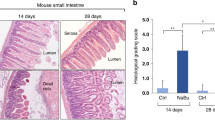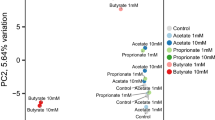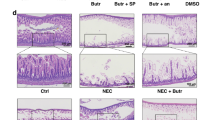Abstract
Production of short-chain fatty acids (SCFA) in the intestinal lumen may play an important role in the maintenance of the intestinal barrier. However, overproduction/accumulation of SCFA in the bowel may be toxic to the intestinal mucosa and has been hypothesized to play a role in the pathogenesis of neonatal necrotizing enterocolitis (NEC). By using a Caco-2 cell monolayer model of intestinal barrier, we report here that the effect of butyrate on the intestinal barrier is paradoxical. Butyrate at a low concentration (2 mM) promotes intestinal barrier function as measured by a significant increase in transepithelial electrical resistance (TER) and a significant decrease in inulin permeability. Butyrate at a high concentration (8 mM) reduces TER and increases inulin permeability significantly. Butyrate induces apoptosis and reduces the number of viable Caco-2 cells in a dose-dependent manner. Intestinal barrier function impairment induced by high concentrations of butyrate is most likely related to butyrate-induced cytotoxicity due to apoptosis. We conclude that the effect of butyrate on the intestinal barrier is paradoxical; i.e. whereas low concentrations of butyrate may be beneficial in promoting intestinal barrier function, excessive butyrate may induce severe intestinal epithelial cell apoptosis and disrupt intestinal barrier.
Similar content being viewed by others
Log in or create a free account to read this content
Gain free access to this article, as well as selected content from this journal and more on nature.com
or
Abbreviations
- NEC:
-
necrotizing enterocolitis
- SCFA:
-
short-chain fatty acids
- TER:
-
transepithelial electrical resistance
References
Ismail AS, Hooper LV 2005 Epithelial cells and their neighbors. IV. Bacterial contributions to intestinal epithelial barrier integrity. Am J Physiol Gastrointest Liver Physiol 289: G779–G784
Bond JH, Levitt MD 1976 Fate of soluble carbohydrate in the colon of rats and man. J Clin Invest 57: 1158–1164
Sakata T 1987 Stimulatory effect of short-chain fatty acids on epithelial cell proliferation in the rat intestine: a possible explanation for trophic effects of fermentable fiber, gut microbes and luminal trophic factors. Br J Nutr 58: 95–103
Roediger WE 1982 Utilization of nutrients by isolated epithelial cells of rat colon. Gastroenterology 83: 424–429
Koruda MJ, Rolendalli RH, Bliss DZ, Hastings J, Rombeau JL, Settle RG 1990 Parenteral nutrition supplemented with short-chain fatty acids: effect on the small-bowel mucosa in normal rats. Am J Clin Nutr 51: 685–689
Rouwet EV, Heineman E, Buurman WA, Riet GT, Ramsay G, Blanco CE 2002 Intestinal permeability and carrier-mediated monosaccharide absorption in preterm neonates during the early postnatal period. Pediatr Res 51: 64–70
Kansagra K, Stoll B, Rognerud C, Niinikoski H, Ou CN, Harvey R, Burrin D 2003 Total parenteral nutrition adversely affects gut barrier function in neonatal piglets. Am J Physiol Gastrointest Liver Physiol 285: G1162–G1170
Nankova BB, Chua J, Mishra R, Kobasiuk CD, La Gamma EF 2003 Nicotinic induction of preproenkephalin and tyrosine hydroxylase gene expression in butyrate-differentiated rat PC12 cells: a model for adaptation to gut-derived environmental signals. Pediatr Res 53: 113–118
Clark DA, Thompson JE, Weiner LB, McMillan JA, Scneider AJ, Rokahr JE 1985 Necrotizing enterocolitis: intraluminal biochemistry in human neonates and a rabbit model. Pediatr Res 19: 919–921
Sangild PT, Siggers RH, Schmidt M, Elnif J, Bjornvad CR, Thymann T, Grondahl ML, Hansen AK, Jensen SK, Boye M, Moelbak L, Buddington RK, Westrom BR, Holst JJ, Burrin DG 2006 Diet- and colonization-dependent intestinal dysfunction predisposes to necrotizing enterocolitis in preterm pigs. Gastroenterology 130: 1776–1792
Lin J 2004 Too much short chain fatty acids cause neonatal necrotizing enterocolitis. Med Hypotheses 62: 291–293
Wilson AJ, Gibson PR 1997 Short-chain fatty acids promote the migration of colonic epithelial cells in vitro. Gastroenterology 113: 487–496
Mariadason JM, Barkla DH, Gibson PR 1997 Effect of short-chain fatty acids on paracellular permeability in Caco-2 intestinal epithelium model. Am J Physiol 272: G705–G712
Mariadason JM, Kilias D, Catto-Smith A, Gibson PR 1999 Effect of butyrate on paracellular permeability in rat distal colonic mucosa ex vivo.. J Gastroenterol Hepatol 14: 873–879
Basuroy S, Sheth P, Kuppuswamy D, Balasubramanian S, Ray RM, Rao RK 2003 Expression of kinase-inactive c-Src delays oxidative stress-induced disassembly and accelerates calcium-mediated reassembly of tight junctions in the Caco-2 cell monolayer. J Biol Chem 278: 11916–11924
Mosmann T 1983 Rapid colorimetric assay for cellular growth and survival: application to proliferation and cytotoxicity assays. J Immunol Methods 65: 55–63
Crew TE, Elder DJ, Paraskeva C 2000 A cyclooxygenase-2 (COX-2) selective non-steroidal anti-inflammatory drug enhances the growth inhibitory effect of butyrate in colorectal carcinoma cells expressing COX-2 protein: regulation of COX-2 by butyrate. Carcinogenesis 21: 69–77
Bojarski C, Gitter AH, Bendfeldt K, Mankertz J, Schmitz H, Wagner S, Fromm M, Schulzke JD 2001 Permeability of human HT-29/B6 colonic epithelium as a function of apoptosis. J Physiol 535: 541–552
Udall JN, Pang K, Fritze L, Kleinman R, Walker WA 1981 Development of gastrointestinal mucosal barrier. I. The effect of age on intestinal permeability to macromolecules. Pediatr Res 15: 241–244
Udall JN, Colony P, Fritze L, Pang K, Trier JS, Walker WA 1981 Development of gastrointestinal mucosal barrier. II. The effect of natural versus artificial feeding on intestinal permeability to macromolecules. Pediatr Res 15: 245–249
Schumann A, Nutten S, Donnicola D, Comelli EM, Mansourian R, Cherbut C, Corthesy-Theulaz I, Garcia-Rodenas C 2005 Neonatal antibiotic treatment alters gastrointestinal tract developmental gene expression and intestinal barrier transcriptome. Physiol Genomics 23: 235–245
Sanderson IR Short chain fatty acid regulation of signaling genes expressed by the intestinal epithelium. J Nutr 134: 2004 2450S–2454S
Lin J, Nafday SM, Chauvin SN, Magid MS, Pabbatireddy S, Holzman IR, Babyatsky MW 2002 Variable effects of short chain fatty acids and lactic acid in inducing intestinal mucosal injury in newborn rats. J Pediatr Gastroenterol Nutr 35: 545–550
Nafday SM, Chen W, Peng LY, Babyatsky MW, Holzman IR, Lin J 2005 Short chain fatty acids induce colonic mucosal injury in rats with different postnatal ages. Pediatr Res 57: 201–204
Ruemmele FM, Schwartz S, Seidman EG, Dionne S, Levy E, Lentze MJ 2003 Butyrate induced Caco-2 cell apoptosis is mediated via the mitochondrial pathway. Gut 52: 94–100
Mandal M, Olson DJ, Sharma T, Vadlamudi RK, Kumar R 2001 Butyric acid induces apoptosis by up-regulating Bax expression via stimulation of the c-Jun N-terminal kinase/activation protein-1 pathway in human colon cancer cells. Gastroenterology 120: 71–78
Sakurazawa T, Ohkusa T 2005 Cytotoxicity of organic acids produced by anaerobic intestinal bacteria on cultured epithelial cells. J Gastroenterol 40: 600–609
Vachon PH, Cardin E, Harnois C, Reed JC, Vezina A 2000 Early establishment of epithelial apoptosis in the developing human small intestine. Int J Dev Biol 44: 891–898
Madara JL 1990 Maintenance of the macromolecular barrier at cell extrusion sites in intestinal epithelium: physiological rearrangement of tight junctions. J Membr Biol 116: 177–184
Jones BA, Gores GJ 1997 Physiology and pathophysiology of apoptosis in epithelial cells of the liver, pancreas, and intestine. Am J Physiol 273: G1174–G1188
Bojarski C, Gitter AH, Bendfeldt K, Mankertz J, Schmitz H, Wagner S, Fromm M, Schulzke JD 2001 Permeability of human HT-29/B6 colonic epithelium as a function of apoptosis. J Physiol 535: 541–552
Jones SA, Butler RN, Sanderson IR, Wilson JW 2004 The effect of specific caspase inhibitors on TNF-α and butyrate-induced apoptosis of intestinal epithelial cells. Exp Cell Res 292: 29–39
Mariadason JM, Catto-Smith A, Gibson PR 1999 Modulation of distal colonic epithelial barrier function by dietary fibre in normal rats. Gut 44: 394–399
Author information
Authors and Affiliations
Corresponding author
Additional information
Supported, in part, by National Institutes of Health grant 1-R03-HD049881.
Rights and permissions
About this article
Cite this article
Peng, L., He, Z., Chen, W. et al. Effects of Butyrate on Intestinal Barrier Function in a Caco-2 Cell Monolayer Model of Intestinal Barrier. Pediatr Res 61, 37–41 (2007). https://doi.org/10.1203/01.pdr.0000250014.92242.f3
Received:
Accepted:
Issue date:
DOI: https://doi.org/10.1203/01.pdr.0000250014.92242.f3
This article is cited by
-
A serine-conjugated butyrate prodrug with high oral bioavailability suppresses autoimmune arthritis and neuroinflammation in mice
Nature Biomedical Engineering (2024)
-
Impact of buffered sodium butyrate as a partial or total dietary alternative to lincomycin on performance, IGF-1 and TLR4 genes expression, serum indices, intestinal histomorphometry, Clostridia, and litter hygiene of broiler chickens
Acta Veterinaria Scandinavica (2023)
-
The effect of claudin-15 deletion on cationic selectivity and transport in paracellular pathways of the cecum and large intestine
Scientific Reports (2023)
-
Incorporating the Molecular Mimicry of Environmental Antigens into the Causality of Autoimmune Hepatitis
Digestive Diseases and Sciences (2023)
-
Puerarin alleviates sleep disorders in aged mice related to repairing intestinal mucosal barrier
Natural Products and Bioprospecting (2023)



